- Home Page
- Soft Kites
- ... Octopus Kite
How to Make an Octopus Kite
Step by Step—Page 1 of 5
The MBK Octopus
Learn how to make an octopus kite with these easy-to-follow instructions—fully illustrated with closeup photos, every step of the way.
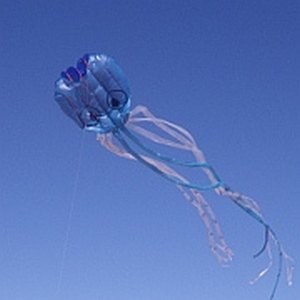 MBK Octopus
MBK OctopusThese instructions will take you step bystep through making an 84 cm (35 in.) wide octopus kite. Height? Over 5 m (16 ft.), including the long tentacles! This six-cell inflatable kite performs best in gentle to moderate wind speeds. That's 12 to 28 kph or 8 to 18 mph. Toward the low end of that range, the kite will hang in the air at low line angles. With more wind speed, the line angle will increase to 45 degrees or slightly more, with a firm pull.
Some of the lines are longer than the standard 30 cm (12 in.) of most rulers. So a handy trick is to stretch out a length of flying line, weigh it down at each end, and then make several dots beside it—less than a ruler length apart. The dots can then be joined by using your ruler. With care, you will end up with a perfectly straight long ruled line every time.
The MBK Octopus kite is inspired by similar-looking retail kites but is not a copy of any of them. For a start, this one uses only straight lines! This tape-and-plastic version works in exactly the same way and has been tested up to 300 feet off the ground—20-pound Dacron flying line is ideal.
Materials for this
kite
The kite described here will do well with just about any fairly robust plastic sheet. Using plastic that is only slightly stretchy when handled and slightly see-through is a good idea. For example, heavy-duty painters' drop sheet or drop-cloth plastic. That would be around four mil thickness for those buying or reusing plastic sheet in the USA.
However, for the outer six tails, I suggest using as light a plastic as you can find! It can be so see-through you could read a book through it. :-) There is no point in weighing the kite down unnecessarily.
Ordinary clear sticking tape in a dispenser is good for tacking seams together before laying down more of the same along the full length. I used the 1.8 cm (3/4 in.) wide variety to ensure adequate strength.
These instructions illustrate an octopus made with 20-pound (strength) Dacron bridle lines plus a short length of 50-pound Dacron. This type of line is readily available from eBay and Amazon online stores. You would get away with 30-pound line throughout.
Upper and Lower Surfaces
When this kite flies, one surface of the sail faces the sky—the upper surface. The other surface is easily visible from the ground—the lower surface. In between the two surfaces are vertical panels called ribs.
On this site, there's more kite-making info than you can poke a stick at. :-)
Want to know the most convenient way of using it all?
The Big MBK E-book Bundle is a collection of downloads—printable PDF files which provide step-by-step instructions for many kites large and small.
That's every kite in every MBK series.
How to Make an Octopus Kite
Making Upper
Surface
Measuring Upper Surface
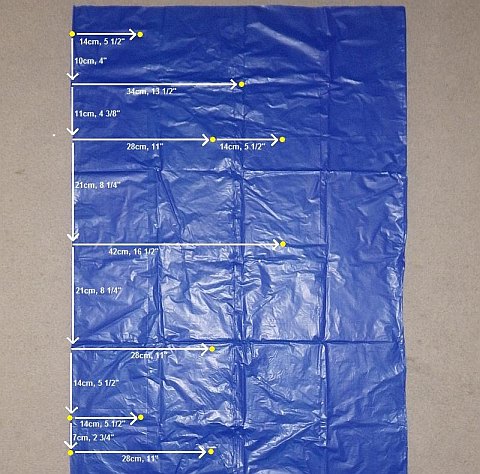 Measured and dots marked
Measured and dots marked- Place your plastic sheeting on the floor. Fold it in half from left to right, and run a sharp straight crease down the left-hand side.
- Starting from near the top left corner, measure and mark dots on the plastic. Just follow the arrows marked on the photo. Dots have been highlighted in yellow.
Judge the horizontal directions by eye. If you're careful, there's no need for a T-square.
Completing Dots for Upper Surface
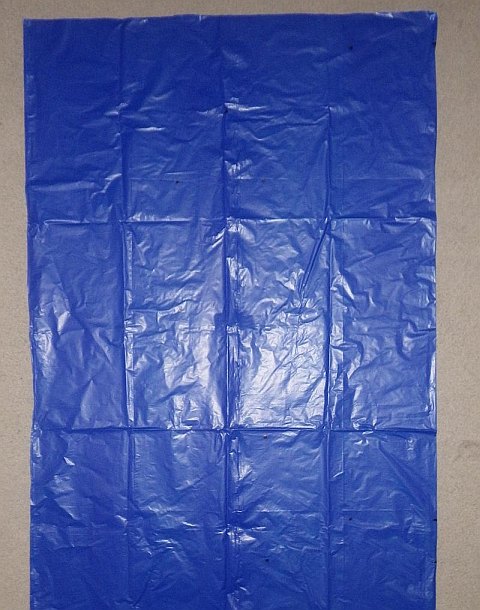 Plastic flipped, dots traced
Plastic flipped, dots traced- Flip all the plastic over. Smooth out the two layers of plastic, double checking that the vertical crease stays in place.
- Make dots over all the dots showing through the two layers of plastic. Keep checking that nothing has slipped! Most of the traced dots are visible in the photo.
Hint: If it's too hard to see through the plastic, just lay it up against a sunlit window!
Drawing Lines for Upper Surface
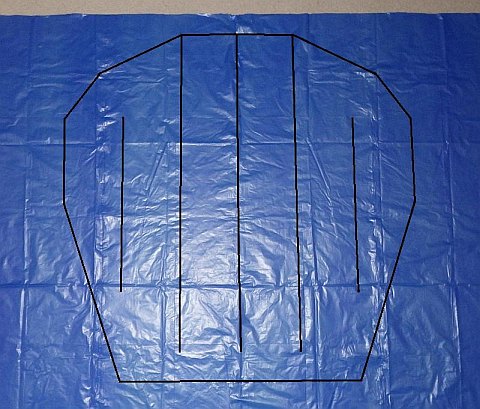 All lines marked
All lines marked- Open out the sheet of plastic, and lay it flat.
- Connect the dots with marked lines as shown in the photo. Some lines are the sail shape, while others are internal guide lines—like the line drawn over the central crease.
Note: The photo has been edited to make the lines darker and easier to see.
Taping Upper Surface
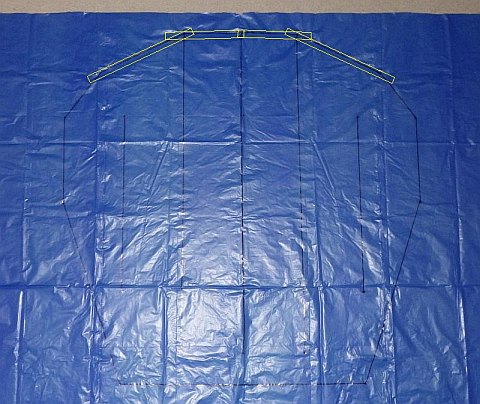 Where to put sticking tape edging
Where to put sticking tape edging- Lay down 1.8 cm (3/4 in.) sticking tape where indicated by yellow rectangles in the photo above. Note that most of the tape is stuck inside the outline.
Cutting Upper Surface
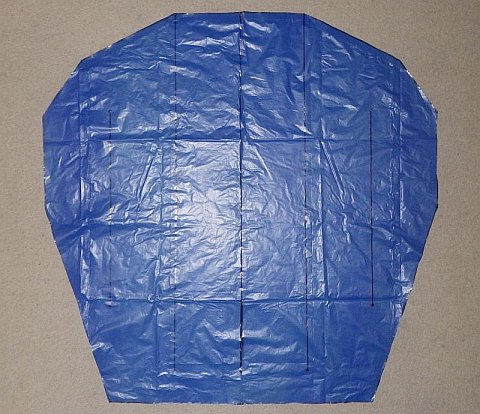 Upper surface sheet cut
Upper surface sheet cut- Take your scissors, and cut all around the outside of the shape along the black lines. When you are finished, the plastic should look like the photo up there, with internal guide lines still intact.
Making Lower Surface
This ends up looking very similar to the upper surface. In fact, rather than doing the measuring all over again, it's simpler to start by tracing.
Tracing Lower Surface
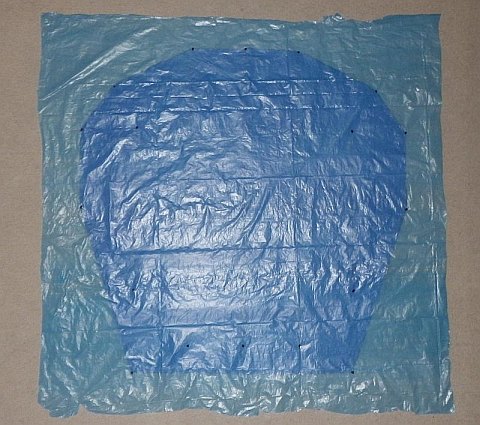 Dots traced onto lower surface plastic
Dots traced onto lower surface plastic- Lay out the upper surface plastic on the floor, with the black lines facing up.
- Lay out enough lower surface plastic to fully cover the upper surface plastic. A fairly light-colored plastic for the lower surface is a good idea so you can see through it!
- Make sure both layers of plastic are lying down smooth and flat.
- With your permanent marker, make dots at all the corners and line ends. That's 18 dots in all. See the photo up there, where all the dots are just visible.
Drawing Lines for Lower Surface
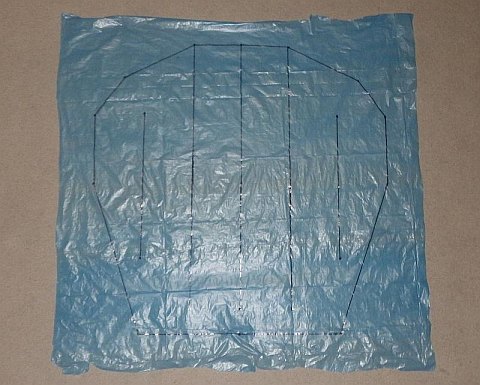 All lines marked
All lines marked- At this point you can remove the piece of plastic that is closest to the floor.
- Connect the dots with marked lines as shown in the photo. Notice how some dots are at corners, while others show where to draw the vertical lines.
Modifying Lower Surface Outline
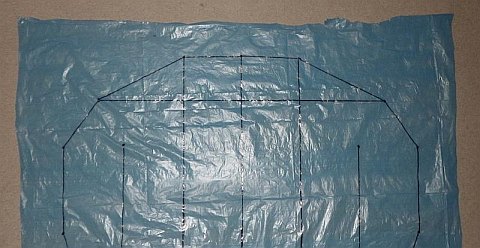 Extra line drawn across the lower surface
Extra line drawn across the lower surface- Draw another line now, between those two corners near the top of the shape. See the photo up there to get it right.
Taping Lower Surface
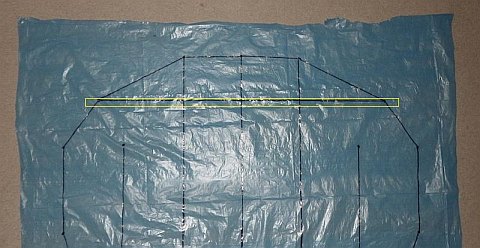 Where to put sticking tape edging
Where to put sticking tape edging- Lay down 1.8 cm (3/4 in.) sticking tape where indicated by the yellow rectangle in the photo above. Note that most of the tape is stuck below the line.
Cutting Lower Surface
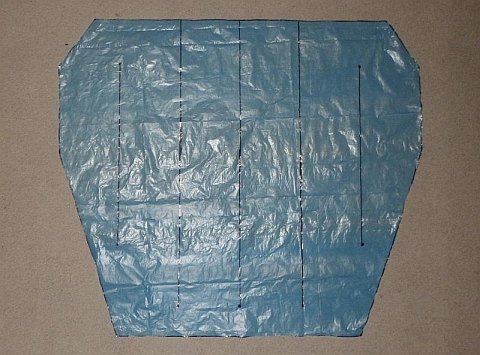 Lower surface sheet cut
Lower surface sheet cut- Take your scissors, and cut all around the outside of the shape along the black lines. Note: Cut along the taped line! This is where the lower surface plastic shape is different to the upper surface plastic.
- When you are finished, the plastic should look like the photo up there, with internal guide lines still intact.
OPTIONAL: Drawing Eyes
The approach here will be for you to position and
trace out circles using whatever handy circular objects you can
find. Everybody has cups and saucers, for example! You can use a
nonpermanent marker, initially, so any little accidents can be
cleaned up. Then the final look can be achieved with a black permanent
marker.
 The eye outlines drawn onto the lower surface plastic
The eye outlines drawn onto the lower surface plastic- Place the lower surface plastic with the guidelines and tape edging facing the floor.
- Using an object that has a diameter of roughly ¾ of the distance between the vertical lines, trace a circle as in the photo on the left. Position the object carefully, with reference to the guidelines showing through before putting pen to plastic.
- Using an object that has roughly twice the diameter of the first object you used, trace a second circle. Note where it touches a vertical line and where it comes close to the first circle. This should be clear in the middle photo.
- Now copy your work across to the other side. See the photo on the right.
Finally, fill in
the "pupils" and thicken up the larger circles until you like the
look. Remember, it will mostly be seen from quite a distance away.
See the photo below.
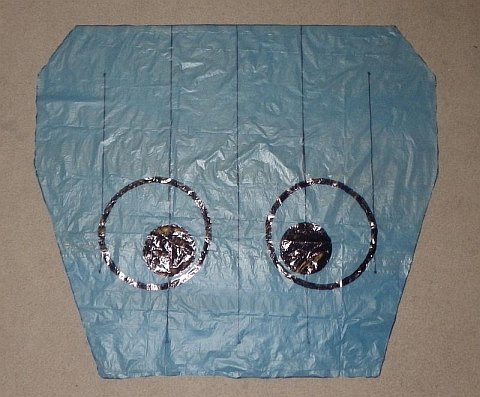 The completed octopus eyes
The completed octopus eyes
As mentioned earlier, there's more kite making on this site than you can poke a stick at. :-)
Want to know the most convenient way of using it all?
The Big MBK E-book Bundle is a collection of downloads—printable PDF files which provide step-by-step instructions for many kites large and small.
That's every kite in every MBK series.
